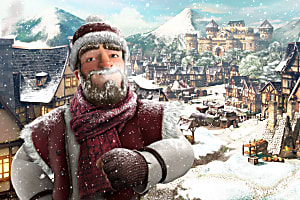Decades ago, much before made-in-China cribs, plastic stars, artificial trees, readymade sweets and smart gadgets hit the market, the Christmas spirit had a touch of creative adventure besides, of course, the family and community ethos.
Creativity was rife and members of the family, extended family and neighbours pooled resources and spent quality time together to make the festival a memorable one.
The joy lay in coming together to prepare 'nevreos', 'manddare', 'kormbolam' and other Christmas goodies. A couple of weeks before Christmas, 'manddare' were some of the first items to be made. "It was fun as preparing the manddare needed skill, which could only be gained with practice," recalls an old-timer.
Everything was made from scratch, and the labour and love helped the neighbourhood spend quality time together to make the festival a memorable one.
Senior citizen
Raul Monteiro recalls all his siblings helping their mother make sweets, even if it only meant making the design on the 'nevreos' with a fork.
This 'sweet' love and warmth was then spread to neighbours and relatives.
At a time when plastic hadn't taken over people's kitchens, the 'cusoado', an elaborate spread consisting of 'nevreos', 'kulkuls', 'bebinca', 'dodol', 'doce' and other sweets, was sent in large porcelain plates covered with a pretty lace cloth to the homes of relatives and neighbours where they were emptied and refilled.
Monteiro recalls many an instance when he and his siblings sheepishly returned, feigning ignorance on how the
Macau blue and white porcelain plates broke en route to the neighbours' homes "We weren't worried about the sweets getting wasted. We didn't know how to break the news of the broken plates," he says, grinning at the memories.
He also recalls his mother staying awake at night to prepare the bebinca on the fire, a painfully slow process.
No Christmas was complete without a beautifully crafted star. Not only was this made by members of the family using bamboo, but the glue used to stick paper over it was made at home with 'maida' and water.
With electrification still a couple of years away, a plank
of wood was fitted inside the large star to accommodate a kerosene lamp. "Often the star would catch fire forcing us to dress it up all over again with paper," Monteiro says.
With the entry of cheap gaudy readymade stars and cribs, the need to bring back handmade work has been felt.
Victor Hugo Gomes, curator of the
Goa Chitra museum, says he was shocked to learn that most people do not know how to make a star from scratch using bamboos. "Christmas was meant to bring families together, but today Chinese products, thermacol and plastic have taken over," he says.
The one star that was made at home has now been replaced by numerous gaudy ones, including coloured bulbs on trees, roofs, everywhere, with simplicity giving way to excess. "These are drawing one away from where the focus ought to be," retired school teacher
Maryanne da
Costa says.
Handmade Christmas cards are another aspect of the festival that have almost become a thing of the past, and it would be the rare house where you would find them strung out on display like they used to be once.
The personal touch is also missing today, with wishes sent via Facebook and WhatsApp, Monteiro says.
Da Costa says dances would only start after midnight mass on Christmas night. "Today they start much earlier, paying scant attention and respect to the spiritual significance of Christmas," she says.
Looking back at his Christmas celebrations in
Panaji as a young boy, writer and professor at Goa College of Art Willy Goes says everybody would walk together to Church and back, exchanging greetings, another aspect that is lacking today. "Despite coffee and cake served after midnight mass, today nobody stays on to socialize and the church is emptied within minutes," he says.
This is precisely the reason 'samudai' were introduced in parishes, to encourage fellowship, parish priest of
Saligao church Fr
Mateus Rodrigues of Mae de Deus Church, Saligao, says.
To bring back the real Christmas spirit he has arranged for a tree in the church compound and has been encouraging parishioners to tie a ribbon around it each time they go out of their way to do a good deed. "If Jesus is born in thousands of cribs throughout the world, but not in our hearts, what's the use of Christmas? The tree is a symbol of good deeds and will be taken during the offertory procession at Christmas mass," he says.
 Children were taught how to make a star from scratch at a recent workshop at Goa Chitra in Benaulim.
Children were taught how to make a star from scratch at a recent workshop at Goa Chitra in Benaulim. Children were taught how to make a star from scratch at a recent workshop at Goa Chitra in Benaulim.
Children were taught how to make a star from scratch at a recent workshop at Goa Chitra in Benaulim.



